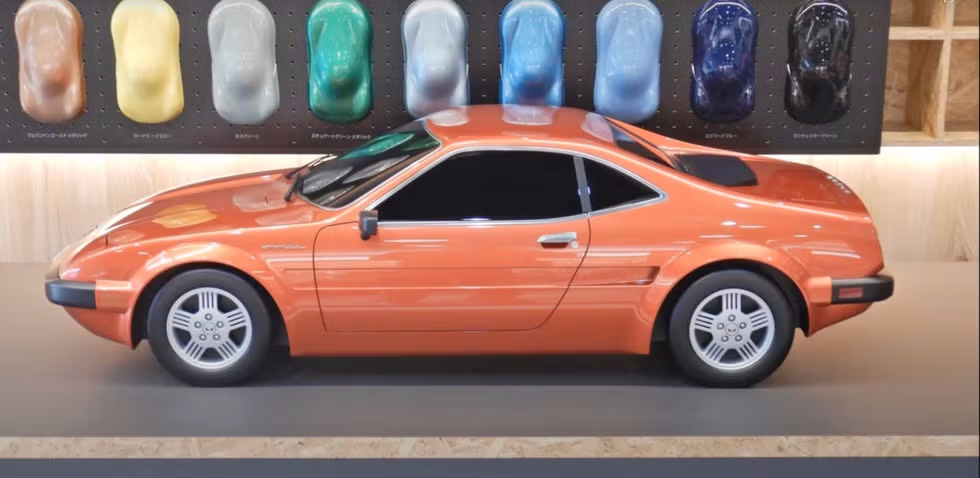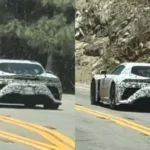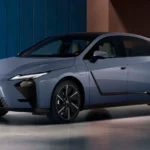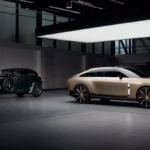Imagine a world where Honda, a name now synonymous with precision engineering and groundbreaking performance, unleashed a world-beating supercar nearly two decades earlier than the iconic NSX. This isn’t just a fantasy; it was a very real ambition. Back in the 1970s, Honda very nearly brought to life an ancestor to its celebrated NSX supercar.
This visionary vehicle would have stood apart significantly from its eventual successor. It was conceived with a powerful V-8 engine at its core, a stark contrast to the V6 that would define the later NSX. What’s more, this V8 would have incorporated Honda’s revolutionary CVCC (Compound Vortex Controlled Combustion) emissions technology. This intriguing piece of automotive history has recently re-emerfaced.
Dedicated volunteers at Honda’s design department meticulously digitized and reimagined the original concept. They even collaborated with the original designers to ensure authenticity. This revival offers a fascinating look at a pivotal moment in Honda’s journey, revealing the company’s bold engineering confidence and its enduring passion for speed.
The Vision of Soichiro Honda: From Racer to Innovator
The genesis of this ambitious 1970s supercar can be traced directly to the pioneering spirit of Honda’s founder, Dr. Soichiro Honda himself.
A Passion for Speed Forged in Wreckage
Before he became the visionary leader of a global automotive empire, Dr. Soichiro Honda harbored a deep passion for motorsports. He was, in fact, a race car driver. While history notes he wasn’t particularly adept at it—famously crashing in his very first race—a profound love of speed and engineering excellence emerged from those early, often chaotic, experiences.
This ingrained passion never waned. It became a guiding principle for his company. This drive for performance is a significant reason why Honda chose to build a sports car, the elegant S500 roadster, as its very first passenger vehicle in 1963. It was a bold statement, defying conventional wisdom that suggested a more utilitarian vehicle for a nascent car manufacturer. This foundational commitment to sporty vehicles laid the groundwork for future high-performance projects.
Bigger Dreams: A Mid-Engined V-8 Supercar
By the 1970s, Honda, as a company, had significantly matured. Its ambitions had grown even larger. The company began to seriously entertain the idea of developing a mid-engined V-8-powered supercar. This was a truly audacious concept for its time, placing Honda in direct competition with established European marques known for their exotic machines.
Of course, in our current reality, Honda did eventually achieve its dream of a world-beating supercar with the launch of the original Acura NSX in 1990. Dr. Honda himself lived just long enough to witness the NSX transform from concept to reality, a moment of immense pride for him. One can only imagine the satisfaction he felt seeing his vision realized.
The recent auction sale of a facelifted first-generation NSX-R for the equivalent of more than $1 million further underscores the enduring legacy and beloved status of the NSX. This remarkable sale proves beyond doubt that Honda’s mid-engined “moonshot” has finally received the credit and reverence it unequivocally deserves from collectors and enthusiasts worldwide.
A Pre-NSX Prototype: Imagining an Earlier Era
To fully grasp the significance of this lost 1970s V8 supercar concept, it’s essential to rewind the clock and envision an alternate automotive timeline.
The “What If” of 1975
Imagine a parallel world where the NSX arrived approximately 15 years earlier, not with a V6 engine, but with the raw power of a V-8 mounted amidships. This concept might initially sound extraordinary, even “crazy,” especially for a company like Honda, which was then primarily known for its motorcycles and fuel-efficient small cars. However, it’s crucial to remember the context of the 1970s. By this decade, Honda was a fully mature company, far from its humble beginnings.
While the Civic had indeed become a runaway commercial success, celebrated more for its thriftiness and groundbreaking efficiency than its sporty handling, Honda had already proven its high-performance credentials on the global stage. The company had achieved remarkable success in Formula 1 racing as far back as the 1960s, demonstrating its engineering prowess at the pinnacle of motorsport. This experience in designing and building high-performance racing engines and chassis provided a solid foundation for ambitious road car projects.
Overflowing Engineering Confidence
Both Honda the man (Dr. Soichiro Honda) and Honda the company were overflowing with engineering confidence during this period. They possessed an unwavering belief in their ability to innovate and solve complex technical challenges. This confidence was perhaps most famously exemplified in one of the cheekiest moments from company history. General Motors (GM) executives, representing the established American automotive giants, had openly scoffed at Honda’s revolutionary Compound Vortex Controlled Combustion (CVCC) technology.
This clean-burning engine design allowed the 1975 Civic to pass stringent new emissions standards without the need for a costly and complex catalytic converter. The GM executives’ dismissive attitude suggested that such advanced, clean-burning technology was only feasible for “motorbikes and tiny cars,” scoffing, “you can’t do that with a proper V-8.”
Dr. Honda, ever the visionary and provocateur, took this challenge personally. He famously bought a Chevrolet Impala equipped with a massive 5.7-liter V-8 engine and had it shipped directly to Japan. There, his engineers meticulously converted the Impala’s V-8 to incorporate CVCC technology, designing and fitting entirely new cylinder heads.
Once the conversion was complete, the Impala was shipped back to the United States. Upon its return, the modified Impala promptly passed emissions tests without a catalytic converter. This daring feat was a resounding “mic drop” moment for Honda, proving their engineering superiority and silencing critics. It validated their belief that sophisticated engineering could overcome perceived limitations. This incident underscored Honda’s willingness to challenge conventions and their technical capability to achieve seemingly impossible feats.
Power and Cleanliness in the “Malaise Era”
The 1970s are often derided by automotive enthusiasts as the “malaise era.” This period saw increasingly strict emission standards that were frequently blamed for “strangling the life out of the muscle-car era,” leading to a significant reduction in horsepower for many iconic American vehicles. However, Honda’s CVCC demonstration proved that good engineering could indeed preserve power while still running clean.
This was a critical insight that would have been vital for a performance-oriented V8 supercar in that era. Unfortunately, there is not much detailed information available today regarding the precise engine displacement Honda planned for its potential 1970s V-8 supercar.
However, given Honda’s engineering philosophy, it’s safe to figure something small and high-revving. This design characteristic was typical of the high-performance engines found in their motorcycles and later performance cars, prioritizing efficiency and power output per liter over sheer size. Such an engine would have been a perfect fit for a lightweight, mid-engined supercar, embodying Honda’s unique approach to performance.
A Svelte V-8 Supercar: Design and Development
The internal discussions and design explorations for Honda’s V8 supercar reveal a clear direction towards a mid-engine layout, a precursor to the NSX’s successful configuration.
Design Exploration: Mid-Engine Emerges Victorious
During the early stages of the supercar concept’s development, Honda’s designers meticulously considered various configurations. They explored both front-engined and mid-engined layouts. Each layout offered distinct advantages in terms of weight distribution, handling characteristics, and aesthetic appeal. However, it was the mid-engined configuration that ultimately progressed to the full-size clay model part of the design process. This decision was highly significant.
It indicated a strong commitment to building a pure sports car, prioritizing dynamic performance and balance. Having already built actual Formula 1 cars from the ground up, including their chassis and engines, Honda engineers possessed an intimate and practical understanding of mid-engined design principles. This invaluable experience would have provided them with a robust foundation for tackling the engineering complexities of a mid-engined road car, ensuring optimal weight distribution and handling.
A Blend of Aesthetics: Prelude Meets Esprit
Early sketches of the car reveal a design aesthetic that appears to be halfway between an elegant Honda Prelude and a sleek Lotus Esprit. The Honda Prelude, a popular sport coupé of the era, was known for its clean lines and accessible sophistication. The Lotus Esprit, on the other hand, was an iconic British mid-engined sports car, famous for its sharp, wedge-like styling and exotic appeal.
The blending of these influences suggests a supercar that would have possessed both Honda’s characteristic refinement and a daring, exotic flair. This fusion could have resulted in a truly distinctive design that stood out in the supercar landscape of the 1970s, offering a unique Japanese interpretation of a high-performance machine. The decision to proceed with a mid-engined layout for the clay model phase confirmed Honda’s commitment to creating a vehicle that was not just powerful, but also dynamically superior.
From Lost Concept to Digital Revival
Despite its promising beginnings, the mid-engined Honda sports car concept unfortunately did not progress beyond the mid-1970s. The project eventually faded, leaving behind only sketches and internal models.
The Static Revival: A Quarter-Scale Model
For decades, this fascinating “what-if” piece of Honda’s history remained largely unseen by the public. However, thanks to the dedicated efforts of some passionate volunteers from Honda’s design department, this lost supercar concept has recently been brought back to life in a tangible, albeit static, form. These volunteers meticulously reconstructed the car, initially creating a one-fourth-scale model.
While this might seem small—as the fictional fashionista Derek Zoolander might famously quip, “[it] needs to be at least three times bigger than this” to be truly “super”—it provided a crucial physical representation of the design. This scale model served as a vital step in bridging the gap between original sketches and a modern digital rendering, allowing for precise measurements and accurate recreation of its proportions and curves.
Digital Reconstruction and Original Approval
The process of bringing this historical concept into the 21st century involved a blend of traditional craftsmanship and advanced technology. The volunteers carefully created a 3-D wireframe model based directly on the original physical models and archival sketches. This digital wireframe provided the foundational structure. From there, they meticulously built out the surfaces using specialized 3-D software, meticulously recreating every curve, line, and detail of the envisioned supercar.
To ensure the utmost authenticity and fidelity to the original vision, the project took an extraordinary step: they brought in the original designers who worked on the 1970s concept. These veteran designers were invited to check things over and offer their final approval on the digital rendition. Their invaluable input ensured that the digital model accurately captured the spirit, intent, and subtle nuances of their initial design, making this digital revival as true to the original concept as possible.
A Virtual Future for a Lost Dream
The result of this painstaking digital reconstruction is a stunning rendering of a supercar that, while never built, now looks remarkably vibrant and relevant.
A “What-Might-Have-Been” Realized
In its beautifully rendered model form, this “what-might-have-been” Honda looks truly great. The digital recreation captures the essence of the 1970s supercar aesthetic while showcasing Honda’s distinctive design language. The smooth curves, aggressive stance, and mid-engine proportions hint at the performance capabilities that were intended. Even better than simply being a static digital image, there’s a tantalizing possibility for this faithfully measured virtual model to be handed over to the staff at Gran Turismo.
Driving the Proto-NSX in Gran Turismo
The popular Gran Turismo racing video game series is renowned for its meticulously detailed virtual car models and realistic driving physics. It has a long history of featuring a wide array of concept cars, often allowing players to “drive” vehicles that never made it to production in the real world. Many concepts find their way into the Gran Turismo (GT) universe, offering enthusiasts a unique interactive experience with automotive history and futuristic designs.
The thought of having a virtual go in a proto-NSX with eight cylinders is an incredibly exciting prospect for car enthusiasts and gamers alike. It would offer a rare chance to experience, even in a simulated environment, a piece of Honda’s unrealized performance heritage. One can’t help but feel that Dr. Honda himself would have wanted you to experience this lost dream.
His passion for engineering, speed, and pushing boundaries would undoubtedly have delighted in seeing his unbuilt vision come alive in the virtual realm, allowing a new generation to appreciate the groundbreaking aspirations of 1970s Honda. This digital resurrection ensures that while the physical prototype may not exist beyond a quarter-scale model, its legacy and potential can still be explored and celebrated.







